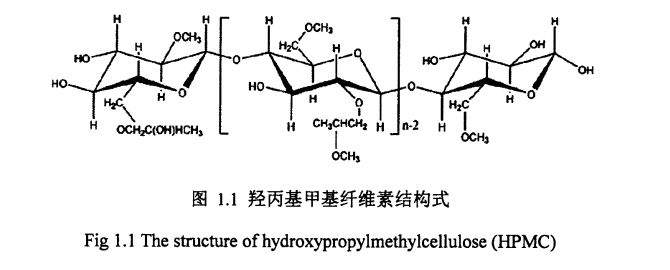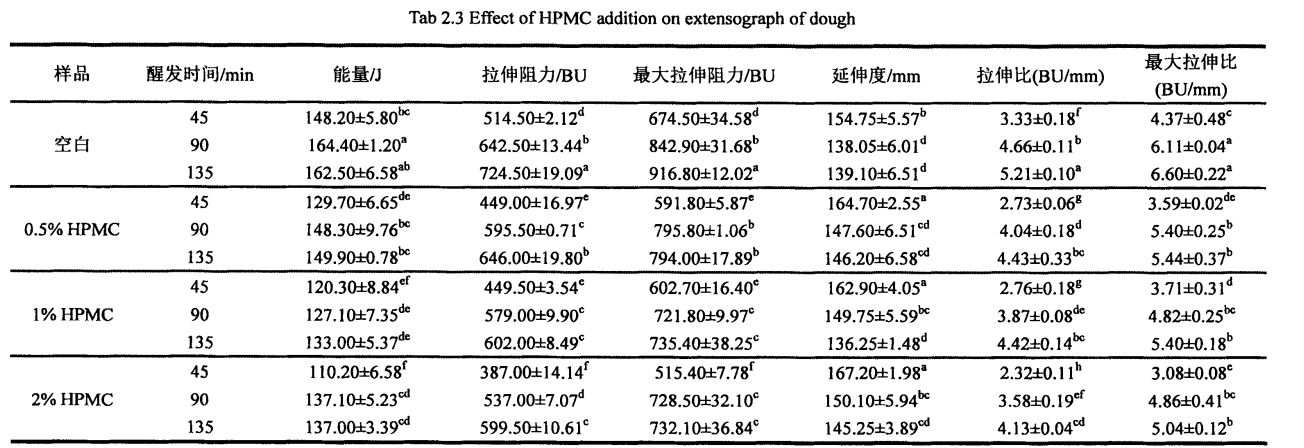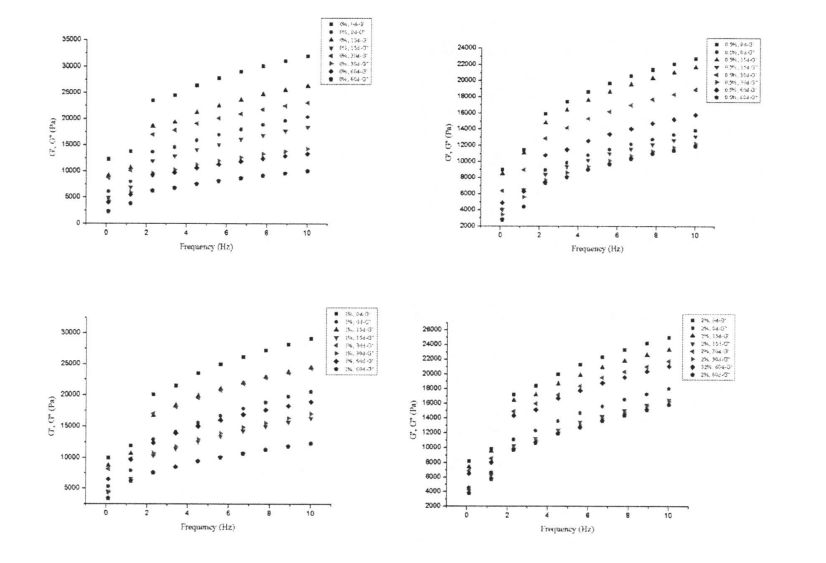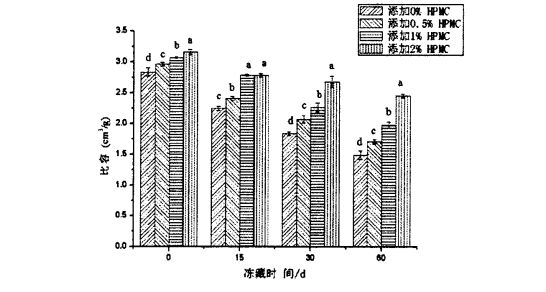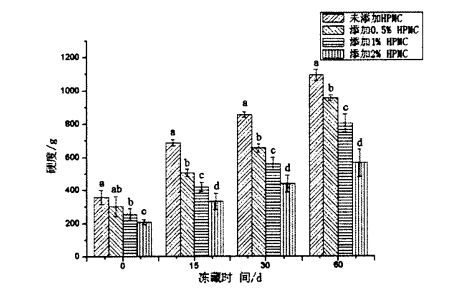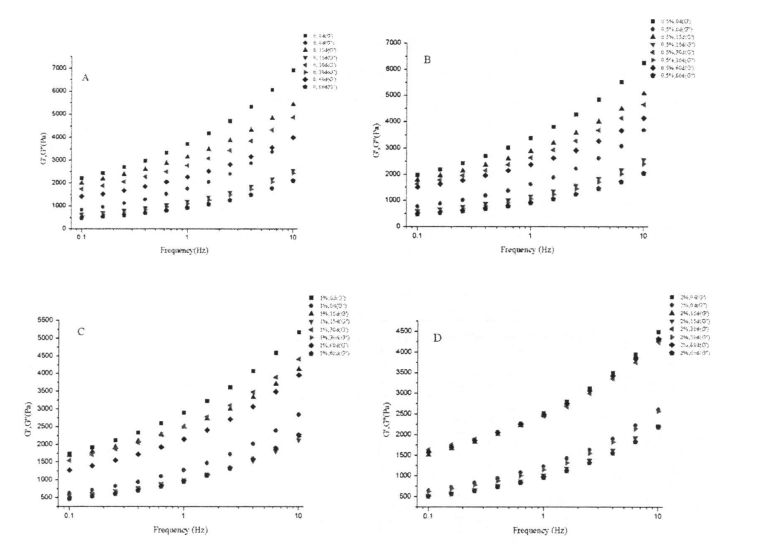Wheat gluten is the material basis for the formation of dough network structure. Experiments found that the addition of I--IPMC reduced the breakage of Yd and disulfide bonds between wheat gluten proteins during frozen storage. In addition, the results of low-field nuclear magnetic resonance and differential scanning the water state transition and recrystallization phenomena are limited, and the content of freezable water in the dough is reduced, thereby suppressing the effect of ice crystal growth on the gluten microstructure and its spatial conformation. Dangosodd sganio microsgop electron yn reddfol y gallai ychwanegu HPMC gynnal sefydlogrwydd strwythur rhwydwaith glwten.
Mae gweithgaredd cynhyrchu nwy eplesu burum yn cael dylanwad pwysig ar ansawdd cynhyrchion blawd wedi'u eplesu. Through experiments, it was found that, compared with the control group, the addition of HPMC could better maintain the fermentation activity of yeast and reduce the increase rate of extracellular reduced glutathione content after 60 days of freezing, and within a certain range, The protective effect of HPMC was positively correlated with its addition amount.
Geiriau allweddol: bara wedi'i stemio; toes wedi'i rewi; hydroxypropyl methylcellulose; glwten gwenith; startsh gwenith; burum.
1.1.4 Problemau a heriau toes wedi'i rewi …………………………………………………………… .3
1.1.7 Hydroxypropyl methyl cellulose (Hydroxypropyl methyl cellulose, I-IPMC) ………. 5
1.3 Prif Gynnwys yr Astudiaeth ....................................................................................................... 7
2.3 Canlyniadau a thrafodaeth arbrofol ………………………………………………………………………. 11
2.4 Crynodeb y Bennod ................................................................................................................................................. 21
3.2.4 Dulliau Arbrofol .............................................................................................................. 25
3.3.2 The effect of adding amount of HPMC and freezing storage time on the freezable moisture content (CFW) and thermal stability……………………………………………………………………. 30
3.3.3 Effects of HPMC addition amount and freezing storage time on free sulfhydryl content (C vessel) …………………………………………………………………………………………………………. . 34
4.1 Introduction .............................................................................................................................. . 44
4.2 Experimental materials and methods ................................................................................. 45
4.2.1 Deunyddiau Arbrofol .................................................................................................... ………… .45
4.3 Analysis and discussion ........................................................................................................... 48
4.3.1 Content of basic components of wheat starch ……………………………………………………. 48
4.3.3 Effects of HPMC addition and freezing storage time on the shear viscosity of starch paste………………………………………………………………………………………………………………………………………. 52
4.3.6 Effects of I-IPMC addition amount and frozen storage time on the thermodynamic properties of starch ………………………………………………………………………………………………………. . 57
Chapter 5 Effects of HPMC addition on yeast survival rate and fermentation activity under frozen storage conditions………………………………………………………………………………………………. . 62
5.1Introduction .................................................................................................................................... 62
5.2 Deunyddiau a Dulliau ................................................................................................. 62
5.2.2 Experimental methods . . . . . …………………………………………………………………………. 63
5.3 Results and Discussion ............................................................................................................... 64
5.3.3 The effect of adding amount of HPMC and freezing time on the content of glutathione in dough……………………………………………………………………………………………………………66. "
6.1 Conclusion ................................................................................................................................. . 68
6.2 Outlook .......................................................................................................................................... 68
Figure 1.1 The structural formula of hydroxypropyl methylcellulose………………………. . 6
Figure 2.4 The effect of HPMC addition and freezing time on the elasticity of steamed bread………………………………………………………………………………………………………………………………. . 20
Figure 3.1 The effect of HPMC addition and freezing time on the rheological properties of wet gluten…………………………………………………………………………………………………………………………. 30
Figure 3.2 Effects of HPMC addition and freezing time on the thermodynamic properties of wheat gluten………………………………………………………………………………………………………………. . 34
Figure 3.3 Effects of HPMC addition and freezing time on free sulfhydryl content of wheat gluten……………………………………………………………………………………………………………………………... . 35
Figure 3.7 The effect of HPMC addition and freezing time on the microscopic gluten network structure…………………………………………………………………………………………………………... . 43
Ffigur 4.1 Cromlin nodweddiadol gelatinization startsh ............................................................................... 51
Figure 4.2 Fluid thixotropy of starch paste ................................................................................. 52
Figure 4.3 Effects of adding amount of MC and freezing time on the viscoelasticity of starch paste……………………………………………………………………………………………………………………... . 57
Figure 4.5 Effects of HPMC addition and freezing storage time on the thermodynamic properties of starch…………………………………………………………………………………………………………. . 59
Figure 5.2 The effect of HPMC addition and freezing time on the yeast survival rate…………………………………………………………………………………………………………………………………... . 67
Figure 5.3 Microscopic observation of yeast (microscopic examination) …………………………………………………………………………………………………………………………. 68
Table 2.1 The basic ingredient content of wheat flour…………………………………………………. 11
Table 3.2 Effects of I-IPMC addition amount and freezing storage time on the phase transition enthalpy (Yi IV) and freezer water content (e chat) of wet gluten………………………. 31
Table 3.3 Effects of HPMC addition amount and freezing storage time on the peak temperature (product) of thermal denaturation of wheat gluten…………………………………………. 33
Tabl 3.4 Swyddi brig strwythurau eilaidd protein a'u haseiniadau ………… .37
Table 3.6 Effects of I-IPMC addition and freezing storage time on the surface hydrophobicity of wheat gluten……………………………………………………………………………………………. 41
Table 4.3 Effects of I-IPMC addition and freezing time on the shear viscosity of wheat starch paste…………………………………………………………………………………………………………………………. 55
1)Development of new characteristic steamed buns. Through the innovation of steamed bread raw materials and the addition of functional active substances, new varieties of steamed breads have been developed, which have both nutrition and function. Established the evaluation standard for the quality of miscellaneous grain steamed bread by principal component analysis; Fu et a1. (2015) Ychwanegwyd pomace lemwn yn cynnwys ffibr dietegol a pholyphenolau at fara wedi'i stemio, a gwerthuso gweithgaredd gwrthocsidiol bara wedi'i stemio; Hao & Beta (2012) studied barley bran and flaxseed (rich in bioactive substances) The production process of steamed bread [5]; Shiau et a1. (2015) evaluated the effect of adding pineapple pulp fiber on dough rheological properties and steamed bread quality [6].
4) Ymchwil ar wella ansawdd bara wedi'i stemio. Research on the addition and application of steamed bread quality improvers; mainly including additives (such as enzymes, emulsifiers, antioxidants, etc.) and other exogenous proteins [14], starch and modified starch [15], etc. The addition and optimization of the corresponding process It is particularly noteworthy that in recent years, through the use of some exogenous proteins and other additives, gluten-free (free. gluten) pasta products have been developed to meet the requirements of Clefyd coeliag (anghenion dietegol cleifion â chlefyd coeliag [16.1 CIT.
6)Research on the application of new fermented bacteria and sourdough. Jiang, et a1. (2010) Application of Chaetomium sp. fermented to produce xylanase (with thermostable) in steamed bread [2l'; Gerez, et a1. (2012) used two kinds of lactic acid bacteria in fermented flour products and evaluated their quality [221; Wu, et al. (2012) studied the influence of sourdough fermented by four kinds of lactic acid bacteria (Lactobacillus plantarum, Lactobacillus, sanfranciscemis , Lactobacillus brevis and Lactobacillus delbrueckii subsp bulgaricus) on the quality (specific volume, texture, fermentation flavor, etc.) of northern steamed bread [23]; and Gerez, et a1. (2012) used the fermentation characteristics of two kinds of lactic acid bacteria to accelerate the hydrolysis of gliadin to reduce the allergenicity of flour products [24] and other aspects.
Cakes and other pasta products have different degrees of application [26-27]. Yn ôl ystadegau anghyflawn, erbyn 1990, roedd 80% o boptai yn yr Unol Daleithiau yn defnyddio toes wedi'i rewi; 50% of bakeries in Japan also used frozen dough. ugeinfed ganrif
Yn y 1990au, cyflwynwyd technoleg prosesu toes wedi'i rewi i China. With the continuous development of science and technology and the continuous improvement of people's living standards, frozen dough technology has broad development prospects and huge development space
a)How to restrain the quality deterioration of frozen dough with the extension of frozen storage time, especially how to control the influence of the formation and growth of ice crystals on the structure and properties of the three main components of dough (starch, gluten and yeast), is still an issue. Mannau problemus a materion sylfaenol yn y maes ymchwil hwn;
In view of the above problems and challenges of frozen dough, the long-term innovative research on the application of frozen dough technology, the quality control and improvement of frozen dough products, and the related mechanism of changes in the structure and properties of material components in the frozen dough system and quality deterioration Such research is a hot issue in the field of frozen dough research in recent years. Yn benodol, mae'r prif ymchwiliadau domestig a thramor yn ystod y blynyddoedd diwethaf yn canolbwyntio'n bennaf ar y pwyntiau canlynol:
II. Optimization of frozen dough production process, frozen storage conditions and formula. During the production of frozen dough, temperature control, proofing conditions, pre-freezing treatment, freezing rate, freezing conditions, moisture content, gluten protein content, and thawing methods will all affect the processing properties of frozen dough [37]. In general, higher freezing rates produce ice crystals that are smaller in size and more uniformly distributed, while lower freezing rates produce larger ice crystals that are not uniformly distributed. In addition, a lower freezing temperature even below the glass transition temperature (CTA) can effectively maintain its quality, but the cost is higher, and the actual production and cold chain transportation temperatures are usually small. In addition, the fluctuation of the freezing temperature will cause recrystallization, which will affect the quality of the dough.
Iii. Defnyddio ychwanegion i wella ansawdd cynnyrch toes wedi'i rewi. In order to improve the product quality of frozen dough, many researchers have made explorations from different perspectives, for example, improving the low temperature tolerance of material components in frozen dough, using additives to maintain the stability of the dough network structure [45.56], etc. Among them, the use of additives is an effective and widely used method. Mainly include, i) enzyme preparations, such as, transglutaminase, O [. Amylase; ii) emulsifiers, such as monoglyceride stearate, DATEM, SSL, CSL, DATEM, etc.; iii) antioxidants, ascorbic acid, etc.; iv) polysaccharide hydrocolloids, such as guar gum, yellow Originalgum, gum Arabic, konjac gum, sodium alginate, etc.; v) other functional substances, such as Xu, et a1. (2009) added Ice-structuring Proteins to wet gluten mass under freezing conditions, and studied its protective effect and mechanism on the structure and function of gluten protein [y71.
Ⅳ. Breeding of antifreeze yeast and application of new yeast antifreeze [58-59]. Sasano, et a1. (2013) obtained freeze-tolerant yeast strains through hybridization and recombination between different strains [60-61], and S11i, Yu, & Lee (2013) studied a biogenic ice nucleating agent derived from Erwinia Herbicans used to protect the fermentation viability of yeast under freezing conditions [62J.
The chemical nature of hydrocolloid is a polysaccharide, which is composed of monosaccharides (glucose, rhamnose, arabinose, mannose, etc.) through 0 [. 1-4. Bond glycosidig neu/ac a. 1--"6. Glycosidic bond or B. 1-4. Glycosidic bond and 0 [.1-3. The high molecular organic compound formed by the condensation of glycosidic bond has a rich variety and can be roughly divided into: ① Cellulose derivatives , such as methyl cellulose (MC), carboxymethyl cellulose (CMC); ② plant polysaccharides, such as konjac gum, guar gum, gum Arabic ; ③ seaweed polysaccharides, such as seaweed gum, carrageenan; ④ microbial polysaccharides, such as Xanthan gum .Polysaccharide has strong hydrophilicity because it contains a large number of hydroxyl groups that are easy to form hydrogen bonds with water, and has the functions of controlling the migration, state and distribution of water in the food system. Therefore, the addition of hydrophilic colloids gives food Many functions, properties, and qualities of hydrocolloids are closely related to the interaction between polysaccharides and water and other macromolecular substances. At the same time, due to the multiple functions of thickening, stabilizing, and water retention, hydrocolloids are widely used to include wrth brosesu bwyd cynhyrchion blawd. Wang Xin et al. (2007) studied the effect of adding seaweed polysaccharides and gelatin on the glass transition temperature of dough [631. Wang Yusheng et al. (2013) believed that compound addition of a variety of hydrophilic colloids can significantly change the flow of dough. Change the properties, improve the tensile strength of the dough, enhance the elasticity of the dough, but reduce the extensibility of the dough [delete.
Although HPMC has been used in pasta to a certain extent, it is mainly used as an anti-aging agent and water-retaining agent for bread, etc., which can improve product specific volume, texture properties and prolong shelf life [71.74]. However, compared with hydrophilic colloids such as guar gum, xanthan gum, and sodium alginate [75-771], there are not many studies on the application of HPMC in frozen dough, whether it can improve the quality of steamed bread processed from frozen dough. Mae yna ddiffyg adroddiadau perthnasol o hyd ar ei effaith.
Effects of addition amount and frozen storage time on the structure and properties of frozen dough, the quality of frozen dough products (steamed bread), the structure and properties of wheat gluten, the structure and properties of wheat starch, and the fermentation activity of yeast. Yn seiliedig ar yr ystyriaethau uchod, gwnaed y dyluniad arbrofol canlynol yn y pwnc ymchwil hwn:
Pennod 2 Effeithiau ychwanegiad I-IPMC ar eiddo prosesu toes wedi'i rewi ac ansawdd bara wedi'i stemio
Generally speaking, the material composition of dough used for making fermented flour products mainly includes biological macromolecular substances (starch, protein), inorganic water, and yeast of organisms, and is formed after hydration, cross-linking and interaction. Mae system ddeunydd sefydlog a chymhleth gyda strwythur arbennig wedi'i datblygu. Mae astudiaethau niferus wedi dangos bod priodweddau'r toes yn cael effaith sylweddol ar ansawdd y cynnyrch terfynol. Therefore, by optimizing the compounding to meet the specific product and it is a research direction to improve the dough formulation and technology of the quality of the product or food for use; on the other hand, improving or improving the properties of dough processing and preservation to ensure or improve the quality of the product is also an important research issue.
C21. KT2134 Popty Sefydlu
Powder meter. E
Extensometer. E
Rheomedr cylchdro R3 Discovery
Wneuthurwr
Brabender, yr Almaen
Brabender, yr Almaen
Huang Shi Heng Feng Medical Equipment Co., Ltd.
Cyfeiriwch at y broses gwneud toes o GB/T 17320.1998 [84]. Weigh 450 g of flour and 5 g of active dry yeast into the bowl of the dough mixer, stir at low speed to fully mix the two, and then add 245 mL of low-temperature (Distilled water (pre-stored in the refrigerator at 4°C for 24 hours to inhibit the activity of yeast), first stir at low speed for 1 min, then at medium speed for 4 min until dough is formed. Take out the dough and divide it into about 180g / portion, knead it into a cylindrical shape, then seal it with a ziplock bag, and put it in. Freeze at 18°C for 15, 30, and 60 days. Add 0.5%, 1%, 2% (w/w, dry basis) HPMC to replace the corresponding proportion of flour quality to make dough, and the rest of the production methods remain unchanged. The 0-day frozen storage (unfrozen storage) was used as the control experimental group.
A sample (about 2 g) of the central part of the partially melted dough was cut and placed on the bottom plate of the rheometer (Discovery R3). Yn gyntaf, roedd y sampl yn destun sganio straen deinamig. The specific experimental parameters were set as follows: A parallel plate with a diameter of 40 mm was used, the gap was set to 1000 mln, the temperature was 25 °C, and the scanning range was 0.01%. 100%, the sample rest time is 10 min, and the frequency is set to 1Hz. The Linear Viscoelasticity Region (LVR) of the tested samples was determined by strain scanning. Then, the sample was subjected to a dynamic frequency sweep, and the specific parameters were set as follows: the strain value was 0.5% (in the LVR range), the resting time, the fixture used, the spacing, and the temperature were all consistent with the strain sweep parameter settings. Five data points (plots) were recorded in the rheology curve for each 10-fold increase in frequency (linear mode). After each clamp depression, the excess sample was gently scraped with a blade, and a layer of paraffin oil was applied to the edge of the sample to prevent water loss during the experiment. Each sample was repeated three times.
2.2.3.6 Cynnwys Dŵr Rhewadwy (Cynnwys Dŵr Rhewadwy, Penderfyniad Mewnol CF) mewn toes
Weigh a sample of about 15 mg of the central part of the fully melted dough, seal it in an aluminum crucible (suitable for liquid samples), and measure it with a Differential Scanning Calorimetry (DSC). Mae paramedrau penodol y rhaglen wedi'u gosod. As follows: first equilibrate at 20°C for 5 min, then drop to .30°C at a rate of 10"C/min, keep for 10 min, and finally rise to 25°C at a rate of 5"C/min, the purge gas is nitrogen (N2) And its flow rate was 50 mL/min. Using the blank aluminum crucible as a reference, the obtained DSC curve was analyzed using the analysis software Universal Analysis 2000, and the melting enthalpy (day) of the ice crystal was obtained by integrating the peak located at about 0°C. Freezable water content (CFW) is calculated by the following formula [85.86]:
Yn eu plith, 厶 yn cynrychioli gwres cudd lleithder, a'i werth yw 334 J Dan; Mae MC (cyfanswm y cynnwys lleithder) yn cynrychioli cyfanswm y cynnwys lleithder yn y toes (wedi'i fesur yn ôl GB 50093.2010T78]). Each sample was repeated three times.
All experiments were repeated at least three times unless otherwise specified, and the experimental results were expressed as the mean (Mean) ± standard deviation (Standard Deviation). SPSS Statistic 19 was used for analysis of variance (Analysis of Variance, ANOVA), and the significance level was O. 05; Defnyddiwch darddiad 8.0 i dynnu siartiau perthnasol.
2.3.2 Effaith ychwanegiad I-IPMC ar briodweddau farinaceous toes
2.3.3 Effaith ychwanegiad HPMC ar eiddo tynnol toes
J (ychwanegwyd 2% HPMC). At the same time, the maximum tensile resistance of the dough decreased from 674.50-a: 34.58 BU (blank) to 591.80--a: 5.87 BU (adding 0.5% HPMC), 602.70± 16.40 BU (1% HPMC added), and 515.40-a: 7.78 BU (2% HPMC added). However, the elongation of the dough increased from 154.75+7.57 MITI (blank) to 164.70-a: 2.55 m/rl(adding 0.5% HPMC), 162.90-a: 4 .05 min (1% HPMC added), and 1 67.20-a: 1.98 min (2% HPMC added). This may be due to the increase of the plasticizer-water content by adding HPMC, which reduces the resistance to the deformation of the gluten protein molecular chain, or the interaction between HPMC and the gluten protein molecular chain changes its stretching behavior, which in turn affects It improves the tensile properties of the dough and increases the extensibility of the dough, which will affect the quality (eg, specific volume, texture) of the final product.
The specific volume of steamed bread can better reflect the appearance and sensory quality of steamed bread. The larger the specific volume of the steamed bread, the larger the volume of the steamed bread of the same quality, and the specific volume has a certain influence on the appearance, color, texture, and sensory evaluation of the food. A siarad yn gyffredinol, mae byns wedi'u stemio â chyfaint penodol mwy hefyd yn fwy poblogaidd gyda defnyddwyr i raddau.
The specific volume of steamed bread can better reflect the appearance and sensory quality of steamed bread. The larger the specific volume of the steamed bread, the larger the volume of the steamed bread of the same quality, and the specific volume has a certain influence on the appearance, color, texture, and sensory evaluation of the food. A siarad yn gyffredinol, mae byns wedi'u stemio â chyfaint penodol mwy hefyd yn fwy poblogaidd gyda defnyddwyr i raddau.
TPA (Textural Profile Analyses) physical property test can comprehensively reflect the mechanical properties and quality of pasta food, including hardness, elasticity, cohesion, chewiness and resilience. Mae Ffigur 2.3 yn dangos effaith ychwanegiad HPMC ac amser rhewi ar galedwch bara wedi'i stemio. The results show that for fresh dough without freezing treatment, with the increase of HPMC addition, the hardness of steamed bread significantly increases. decreased from 355.55±24.65g (blank sample) to 310.48±20.09 g (add O.5% HPMC), 258.06±20.99 g (add 1% t-IPMC) and 215.29 + 13.37 g (2% HPMC added). Gall hyn fod yn gysylltiedig â'r cynnydd yng nghyfaint penodol y bara wedi'i stemio. In addition, as can be seen from Figure 2.4, as the amount of HPMC added increases, the springiness of steamed bread made from fresh dough increases significantly, from 0.968 ± 0.006 (blank) to 1, respectively. .020 ± 0.004 (add 0.5% HPMC), 1.073 ± 0.006 (add 1% I-IPMC) and 1.176 ± 0.003 (add 2% HPMC). The changes of the hardness and elasticity of steamed bread indicated that the addition of HPMC could improve the quality of steamed bread. This is consistent with the research results of Rosell, Rojas, Benedito de Barber (2001) [95] and Barcenas, Rosell (2005) [worms], that is, HPMC can significantly reduce the hardness of bread and improve the quality of bread.

The hardness of the steamed bread made of frozen dough with 2% HPMC increased from 208.233 ± 15.566 g (frozen storage for 0 days) to 564.978 ± 82.849 g (frozen storage for 60 days). Fig 2.4 Effect of HPMC addition and frozen storage on springiness of Chinese steamed bread In terms of elasticity, the elasticity of steamed bread made from frozen dough without adding HPMC decreased from 0.968 ± 0.006 (freezing for 0 days) to 0.689 ± 0.022 (frozen for 60 days); Frozen with 2% HPMC added the elasticity of the steamed buns made of dough decreased from 1.176 ± 0.003 (freezing for 0 days) to 0.962 ± 0.003 (freezing for 60 days). Obviously, the increase rate of hardness and the decrease rate of elasticity decreased with the increase of the added amount of HPMC in the frozen dough during the frozen storage period. This shows that the addition of HPMC can effectively improve the quality of steamed bread. Yn ogystal, mae Tabl 2.5 yn rhestru effeithiau ychwanegiad HPMC ac amser storio wedi'i rewi ar fynegeion gwead eraill o fara wedi'i stemio. ) had no significant change (P>0.05); however, at 0 days of freezing, with the increase of HPMC addition, the Gumminess and Chewiness decreased significantly (P
Ar y llaw arall, gydag ymestyn yr amser rhewi, gostyngodd cydlyniant ac adfer grym bara wedi'i stemio yn sylweddol. For steamed bread made from frozen dough without adding HPMC, its cohesion was increased by O. 86-4-0.03 g (frozen storage 0 days) was reduced to 0.49+0.06 g (frozen storage for 60 days), while the restoring force was reduced from 0.48+0.04 g (frozen storage for 0 days) to 0.17±0.01 (frozen storage for 0 days) 60 days); however, for steamed buns made from frozen dough with 2% HPMC added, the cohesion was reduced from 0.93+0.02 g (0 days frozen) to 0.61+0.07 g (frozen storage for 60 days), while the restoring force was reduced from 0.53+0.01 g (frozen storage for 0 days) to 0.27+4-0.02 (frozen storage for 60 days). In addition, with the prolongation of frozen storage time, the stickiness and chewiness of steamed bread increased significantly. For the steamed bread made from frozen dough without adding HPMC, the stickiness was increased by 336.54+37. 24 (0 days of frozen storage) increased to 1232.86±67.67 (60 days of frozen storage), while chewiness increased from 325.76+34.64 (0 days of frozen storage) to 1005.83+83.95 (frozen for 60 days); however, for the steamed buns made from frozen dough with 2% HPMC added, the stickiness increased from 206.62+1 1.84 (frozen for 0 days) to 472.84. 96+45.58 (frozen storage for 60 days), while chewiness increased from 200.78+10.21 (frozen storage for 0 days) to 404.53+31.26 (frozen storage for 60 days). Mae hyn yn dangos y gall ychwanegu HPMC atal y newidiadau yn priodweddau gwead bara wedi'i stemio a achosir gan storfa rewi yn effeithiol. In addition, the changes in the texture properties of steamed bread caused by freezing storage (such as the increase of stickiness and chewiness and the decrease of recovery force) There is also a certain internal correlation with the change of steamed bread specific volume. Thus, dough properties (eg, farinality, elongation, and rheological properties) can be improved by adding HPMC to frozen dough, and HPMC inhibits the formation, growth, and redistribution of ice crystals (recrystallization process), making frozen dough The quality of the processed steamed buns is improved.
Hydroxypropyl methylcellulose (HPMC) is a kind of hydrophilic colloid, and its application research in frozen dough with Chinese-style pasta food (such as steamed bread) as the final product is still lacking. The main purpose of this study is to evaluate the effect of HPMC improvement by investigating the effect of HPMC addition on the processing properties of frozen dough and the quality of steamed bread, so as to provide some theoretical support for the application of HPMC in steamed bread and other Chinese-style flour products. Mae'r canlyniadau'n dangos y gall HPMC wella priodweddau farinaceous y toes. Pan fydd swm ychwanegol HPMC yn 2%, mae cyfradd amsugno dŵr y toes yn cynyddu o 58.10%yn y grŵp rheoli i 60.60%; Cynyddodd 2 funud i 12.2 munud; Ar yr un pryd, gostyngodd yr amser ffurfio toes o 2.1 munud yn y grŵp rheoli i 1.5 melin; Gostyngodd y radd wanhau o 55 FU yn y grŵp rheoli i 18 FU. In addition, HPMC also improved the tensile properties of the dough. With the increase in the amount of HPMC added, the elongation of the dough increased significantly; wedi'i leihau'n sylweddol. In addition, during the frozen storage period, the addition of HPMC reduced the increase rate of the freezable water content in the dough, thereby inhibiting the damage to the dough network structure caused by ice crystallization, maintaining the relative stability of the dough viscoelasticity and the integrity of the network structure, thereby improving the stability of the dough network structure. The quality of the final product is guaranteed.
Pennod 3 Effeithiau ychwanegiad HPMC ar strwythur a phriodweddau glwten gwenith o dan amodau rhewi
For frozen dough, under freezing conditions, the formation and growth of ice crystals (crystallization and recrystallization process) will cause the dough network structure to be physically squeezed, and its structural integrity will be destroyed, and microscopically. Accompanied by changes in the structure and properties of gluten protein [105'1061. Fel Zhao, et a1. (2012) found that with the prolongation of freezing time, the molecular weight and molecular gyration radius of gluten protein decreased [107J, which indicated that gluten protein partially depolymerized. In addition, the spatial conformational changes and thermodynamic properties of gluten protein will affect the dough processing properties and product quality. Therefore, in the process of freezing storage, it is of certain research significance to investigate the changes of water state (ice crystal state) and the structure and properties of gluten protein under different freezing storage time conditions.
Gluten Anhui Rui Fu Xiang Food Co., Ltd .; Hydroxypropyl Methylcellulose (HPMC, same as above) Aladdin Chemical Reagent Co., Ltd.
3.2.2 Offer arbrofol
BC/BD. Oergell 272SC
KDC. Centrifuge oergell cyflym 160awr
Pb. Model 10 pH Meter
Wneuthurwr
Cwmni Shanghai Niumet
Offeryn Sbectrwm Shanghai Co., Ltd.
Thermo Nicolet, UDA
Anhui Zhong Ke Zhong Jia Scientific Instrument Co., Ltd.
Huangshi Hengfeng Medical Equipment Co., Ltd.
Cafodd sampl 15 mg o glwten gwlyb ei bwyso a'i selio mewn crucible alwminiwm (sy'n addas ar gyfer samplau hylif). The determination procedure and parameters are as follows: equilibrate at 20°C for 5 min, then drop to .30°C at a rate of 10°C/min, keep the temperature for 10 min, and finally increase to 25°C at a rate of 5°C/min, purge the gas (Purge Gas) was nitrogen (N2) and its flow rate was 50 mL/min, and a blank sealed aluminum crucible was used as a reference. The obtained DSC curve was analyzed using the analysis software Universal Analysis 2000, by analyzing the peaks located around 0 °C. Integral to get the melting enthalpy of ice crystals (Yu day). Then, the freezable water content (CFW) is calculated by the following formula [85-86]:
Yn eu plith, mae tri, yn cynrychioli gwres cudd lleithder, a'i werth yw 334 J/g; Mae MC yn cynrychioli cyfanswm cynnwys lleithder y glwten gwlyb a fesurwyd (wedi'i fesur yn ôl GB 50093.2010 [. 78]). Cafodd pob sampl ei ailadrodd dair gwaith.
(2) Pennu Tymheredd Copa Denaturation Thermol (TP) o brotein glwten gwenith
Freeze-dry the frozen-storage-treated sample, grind it again, and pass it through a 100-mesh sieve to obtain gluten protein powder (this solid powder sample is also applicable to 2.8). A 10 mg gluten protein sample was weighed and sealed in an aluminum crucible (for solid samples). The DSC measurement parameters were set as follows, equilibrated at 20 °C for 5 min, and then increased to 100 °C at a rate of 5 °C/min, using nitrogen as the purge gas, and its flow rate was 80 mL/min. Using a sealed empty crucible as a reference, and use the analysis software Universal Analysis 2000 to analyze the obtained DSC curve to obtain the peak temperature of thermal denaturation of wheat gluten protein (Yes). Mae pob sampl yn cael ei hefelychu deirgwaith.
Among them, 73.53 is the extinction coefficient; A yw'r gwerth amsugno; D yw'r ffactor gwanhau (1 yma); G is the protein concentration. Cafodd pob sampl ei ailadrodd dair gwaith.
All results are expressed as mean 4-standard deviation, and the above experiments were repeated at least three times except for scanning electron microscopy. Use Origin 8.0 to draw charts, and use SPSS 19.0 for one. Dadansoddiad ffordd o amrywiant a phrawf amrediad lluosog Duncan, y lefel arwyddocâd oedd 0.05.
3. Canlyniadau a thrafodaeth
Rheological properties are an effective way to reflect the structure and properties of food materials and to predict and evaluate product quality [113J. Fel y gwyddom i gyd, protein glwten yw'r brif gydran ddeunydd sy'n rhoi viscoelastigedd toes. As shown in Figure 3.1, the dynamic frequency sweep (0.1.10 Hz) results show that the storage modulus (elastic modulus, G') of all wet gluten mass samples is greater than the loss modulus (viscous modulus) , G”), therefore, the wet gluten mass showed solid-like rheological characteristics (Figure 3.1, AD). This result also shows that the intermolecular and intramolecular glutenin The mutual cross-linking structure formed by covalent or non-covalent interaction is the backbone of the dough network structure [114]. At the same time, Sin Qu & Singh (2013) also believed that the rheological properties of dough are related to their protein components [114]. 115]. In addition, with the prolongation of freezing time, the G' and G' moduli of wet gluten doughs with 0%, 0.5% and 1% HPMC added showed different degrees of decrease (Fig. 3.1, 115). AC), and the degree of decrease was negatively correlated with the addition of HPMC, so that the G and G" moduli of wet gluten doughs with 2% HPMC addition did not show a significant increase with the freezing storage time from 0 to 60 days. Sexual differences (Figure 3.1, D). This indicates that the three-dimensional network structure of the wet gluten mass without HPMC was destroyed by the ice crystals formed during the freezing process, which is consistent with the results found by Kontogiorgos, Goff, & Kasapis (2008), who believed that the prolonged freezing time caused the functionality and stability of the dough structure were seriously reduced.
3.3.2.1 Effeithiau swm adio HPMC ac amser storio rhewi ar y Cynnwys Lleithder Rhewadwy (CFW) mewn toes glwten gwlyb
Mae crisialau iâ yn cael eu ffurfio trwy drosglwyddo dŵr rhewadwy yn y cyfnod ar dymheredd is na'i bwynt rhewi. Therefore, the content of freezable water directly affects the number, size and distribution of ice crystals in the frozen dough. The experimental results (Table 3.2) show that as the freezing storage time is extended from 0 days to 60 days, the wet gluten mass Chinese silicon gradually becomes larger, which is consistent with the research results of others [117'11 81]. In particular, after 60 days of frozen storage, the phase transition enthalpy (day) of the wet gluten mass without HPMC increased from 134.20 J/g (0 d) to 166.27 J/g (60 d), that is, the increase increased by 23.90%, while the freezable moisture content (CF silicon) increased from 40.08% to 49.78%, an increase of 19.59%. However, for the samples supplemented with 0.5%, 1% and 2% HPMC, after 60 days of freezing, the C-chat increased by 20.07%, 16, 63% and 15.96%, respectively, which is consistent with Matuda, et a1. (2008) found that the melting enthalpy (Y) of the samples with added hydrophilic colloids decreased compared with the blank samples [119].

The thermal stability of gluten has an important influence on the grain formation and product quality of thermally processed pasta [211]. Mae Ffigur 3.2 yn dangos y gromlin DSC a gafwyd gyda thymheredd (° C) fel yr abscissa a llif gwres (MW) fel yr ordeiniad. The experimental results (Table 3.3) found that the heat denaturation temperature of gluten protein without freezing and without adding I-IPMC was 52.95 °C, which was consistent with Leon, et a1. (2003) and Khatkar, Barak, & Mudgil (2013) reported very similar results [120m11. With the addition of 0% unfrozen, O. Compared with the heat denaturation temperature of gluten protein with 5%, 1% and 2% HPMC, the heat deformation temperature of gluten protein corresponding to 60 days increased by 7.40℃, 6.15℃, 5.02℃ and 4.58℃, respectively. Obviously, under the condition of the same freezing storage time, the increase of denaturation peak temperature (N) decreased sequentially with the increase of HPMC addition. This is consistent with the change rule of the results of Cry. In addition, for the unfrozen samples, as the amount of HPMC added increases, the N values decrease sequentially. This may be due to the intermolecular interactions between HPMC with molecular surface activity and gluten, such as the formation of covalent and non-covalent bonds [122J].
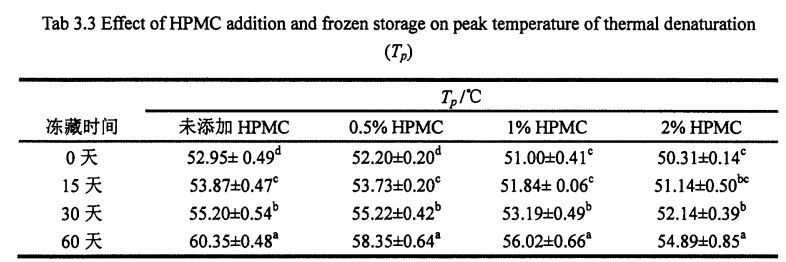
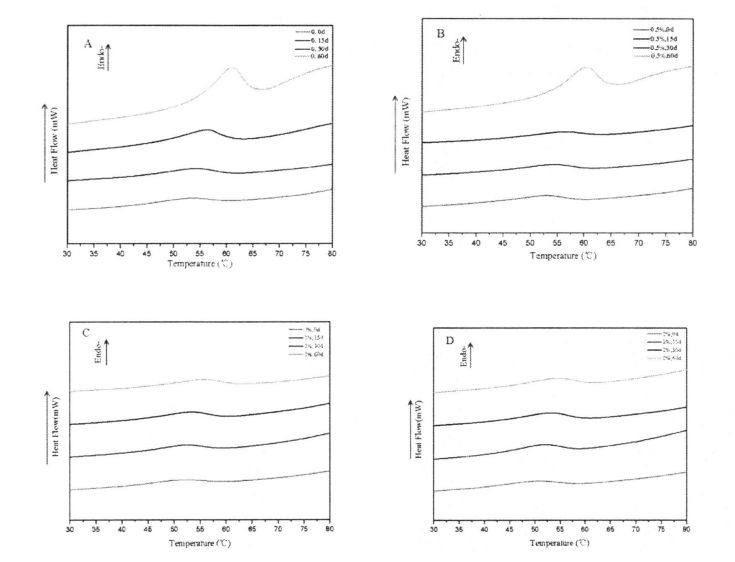
Fig 3.2 Typical DSC thermograms of gluten proteins with 0%HPMC(A);with O.5%HPMC(B); with 1%HPMC(C);with 2%HPMC(D)after different time of frozen storage,from 0d to 60d indicated from the lowest curve to the highest one in each graph. Note: A is the DSC curve of wheat gluten without adding HPMC; B is the addition of O. DSC curve of wheat gluten with 5% HPMC; C yw cromlin DSC glwten gwenith gydag 1% HPMC; D is the DSC curve of wheat gluten with 2% HPMC 3.3.3 Effects of HPMC addition amount and freezing time on free sulfhydryl content (C-SH) Intermolecular and intramolecular covalent bonds are very important for the stability of dough network structure. A disulfide bond (-SS-) is a covalent linkage formed by dehydrogenation of two free sulfhydryl groups (.SH). Glutenin is composed of glutenin and gliadin, the former can form intramolecular and intermolecular disulfide bonds, while the latter can only form intramolecular disulfide bonds [1241] Therefore, disulfide bonds are an intramolecular/intermolecular disulfide bond. important way of cross-linking. Compared to adding 0%, O. The C-SH of 5% and 1% HPMC without freezing treatment and the C-SH of gluten after 60 days of freezing have different degrees of increase respectively. Specifically, the face with no HPMC added gluten C. SH increased by 3.74 "mol/g to 8.25 "mol/g, while C.sh, shellfish, with gluten supplemented with 0.5% and 1% HPMC increased by 2.76 "mol/g to 7.25""mol/g and 1.33 "mol/g to 5.66 "mol/g (Fig. 3.3). Zhao, et a1. (2012) found that after 120 days of frozen storage, the content of free thiol groups increased significantly [ 1071. It is worth noting that the C-SH of gluten protein was significantly lower than that of other frozen storage periods when the freezing period was 15 days, which may be attributed to the freezing shrinkage effect of gluten protein structure, which makes the More intermolecular and intramolecular disulfide bonds were locally formed in a shorter freezing time [1161. Wang, et a1. (2014) found that the C-SH of glutenin-rich proteins was also significantly increased after 15 days of freezing. Decreased [1251. However, the gluten protein supplemented with 2% HPMC did not increase significantly except for C-SH, which also decreased significantly at 15 days, with the extension of freezing time.
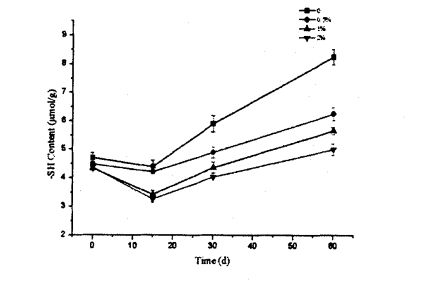
Fig 3.3 Effect of HPMC addition and frozen storage on the content of free-SH for gluten proteins As mentioned above, freezable water can form ice crystals at low temperatures and distribute in the interstices of the gluten network. Therefore, with the prolongation of freezing time, the ice crystals become larger, which squeezes the gluten protein structure more seriously, and leads to the breakage of some intermolecular and intramolecular disulfide bonds, which increases the content of free sulfhydryl groups. On the other hand, the experimental results show that HPMC can protect the disulfide bond from the extrusion damage of ice crystals, thereby inhibiting the depolymerization process of gluten protein. 3.3.4 Effects of HPMC addition amount and freezing storage time on transverse relaxation time (T2) of wet gluten mass The distribution of Transverse Relaxation Time (T2) can reflect the model and dynamic process of water migration in food materials [6]. Figure 3.4 shows the distribution of wet gluten mass at 0 and 60 days with different HPMC additions, including 4 main distribution intervals, namely 0.1.1 ms (T21), 1.10 ms (T22), 10.100 ms (dead;) and 1 00-1 000 ms (T24). Bosmans et al. (2012) found a similar distribution of wet gluten mass [1261], and they suggested that protons with relaxation times below 10 ms could be classified as rapidly relaxing protons, which are mainly derived from poor mobility the bound water, therefore, may characterize the relaxation time distribution of bound water bound to a small amount of starch, while Dang may characterize the relaxation time distribution of bound water bound to gluten protein. In addition, Kontogiorgos (2007) - t11¨, the "strands" of the gluten protein network structure are composed of several layers (Sheets) about 5 nm apart, and the water contained in these layers is limited water (or Bulk water, phase water), the mobility of this water is between the mobility of bound water and free water. A gellir priodoli T23 i ddosbarthiad amser ymlacio dŵr cyfyngedig. Mae gan y dosbarthiad T24 (> 100 ms) amser ymlacio hir, felly mae'n nodweddu dŵr am ddim gyda symudedd cryf. Mae'r dŵr hwn yn bodoli yn mandyllau strwythur y rhwydwaith, a dim ond grym capilari gwan sydd gyda'r system protein glwten.
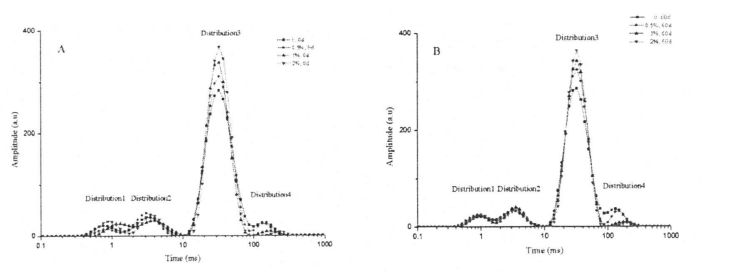
However, there were obvious differences in the height and area of T23 distribution of wet gluten mass that was not frozen and contained different HPMC additions, and with the increase of addition, the height and area of T23 distribution increased (Fig. 3.4). This change shows that HPMC can significantly increase the relative content of limited water, and it is positively correlated with the added amount within a certain range. In addition, with the extension of freezing storage time, the height and area of T23 distribution of the wet gluten mass with the same HPMC content decreased to varying degrees. Felly, o'i gymharu â dŵr wedi'i rwymo, dangosodd dŵr cyfyngedig effaith benodol ar storio rhewi. Sensitifrwydd. Mae'r duedd hon yn awgrymu bod y rhyngweithio rhwng y matrics protein glwten a'r dŵr cyfyng yn mynd yn wannach. This may be because more hydrophobic groups are exposed during freezing, which is consistent with the thermal denaturation peak temperature measurements. In particular, the height and area of the T23 distribution for the wet gluten mass with 2% HPMC addition did not show a significant difference. This indicates that HPMC can limit the migration and redistribution of water, and can inhibit the transformation of the water state from the restricted state to the free state during the freezing process.
Fourier transform infrared spectroscopy (FT-IR) has been widely used for high-throughput determination of the secondary structure of protein samples. The characteristic bands in the infrared spectrum of proteins mainly include, amide I band (1700.1600 cm-1), amide II band (1600.1500 cm-1) and amide III band (1350.1200 cm-1). Correspondingly, the amide I band the absorption peak originates from the stretching vibration of the carbonyl group (-C=O-.), the amide II band is mainly due to the bending vibration of the amino group (-NH-) [1271], and the amide III band is mainly due to the amino bending vibration and .CN-.Synchronous compound vibration in the same plane of bond stretching dirgryniad, ac mae ganddo sensitifrwydd uchel i newidiadau yn strwythur eilaidd protein [128'1291. Although the above three characteristic bands are all characteristic infrared absorption peaks of proteins, the specific In other words, the absorption intensity of amide II band is lower, so the semi-quantitative accuracy of protein secondary structure is poor; while the peak absorption intensity of amide I band is higher, so many researchers analyze the secondary structure of protein by this band [ 1301, but the absorption peak of water and the amide I band are overlapped at about 1640 cm. 1 wavenumber (Overlapped), which in turn affects the accuracy of the results. Felly, mae ymyrraeth dŵr yn cyfyngu ar bennu band amide I mewn penderfyniad strwythur eilaidd protein. In this experiment, in order to avoid the interference of water, the relative contents of four secondary structures of gluten protein were obtained by analyzing the amide III band. Safle brig (egwyl tonfow) o
Rhestrir y priodoli a'r dynodiad yn Nhabl 3.4.
Tab 3.4 Swyddi brig ac aseinio strwythurau eilaidd yn tarddu o fand Amide III mewn sbectra FT-IR

Figure 3.5 is the infrared spectrum of the amide III band of gluten protein added with different contents of HPMC for 0 days after being frozen for 0 days after deconvolution and fitting of the second derivative. (2001) cymhwysodd yr ail ddeilliad i gyd -fynd â'r copaon dadadeiladu â siapiau brig tebyg [1321]. In order to quantify the relative content changes of each secondary structure, Table 3.5 summarizes the relative percentage content of the four secondary structures of gluten protein with different freezing times and different HPMC additions (corresponding peak integral area/peak total area).
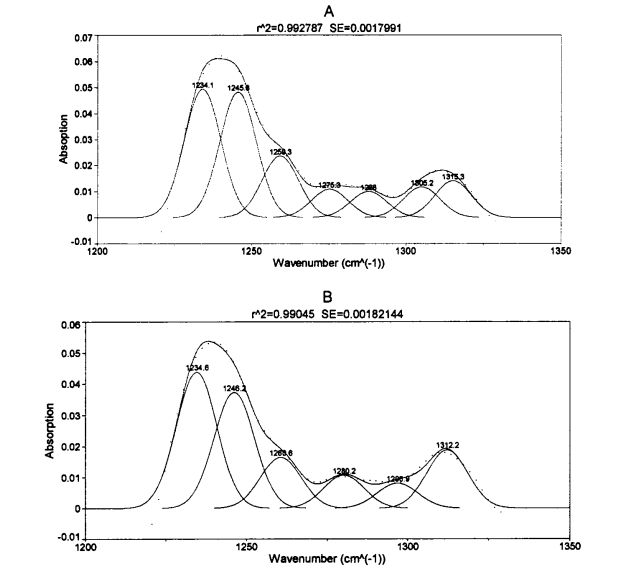
Ffig 3.5 Dad -ddatganoli Band III amide o glwten gydag O % HPMC ar 0 d (a) , gyda 2 % hpmc ar 0 d (b)
With the prolongation of frozen storage time, the secondary structure of gluten protein with different additions of HPMC changed to different degrees. It can be seen that both frozen storage and addition of HPMC have an effect on the secondary structure of gluten protein. Regardless of the amount of HPMC added, B. The folded structure is the most dominant structure, accounting for about 60%. After 60 days of frozen storage, add 0%, OB Gluten of 5% and 1% HPMC. The relative content of folds increased significantly by 3.66%, 1.87% and 1.16%, respectively, which was similar to the results determined by Meziani et al. (2011) [l33J]. However, there was no significant difference during frozen storage for gluten supplemented with 2% HPMC. In addition, when frozen for 0 days, with the increase of HPMC addition, p. The relative content of folds increased slightly, especially when the addition amount was 2%, p. The relative content of folds increased by 2.01%. D. The folded structure can be divided into intermolecular p. Plygu (a achosir gan agregu moleciwlau protein), gwrthffarallel t. Folded and parallel p. Mae tri is -strwythur wedi'u plygu, ac mae'n anodd penderfynu pa is -strwythur sy'n digwydd yn ystod y broses rewi
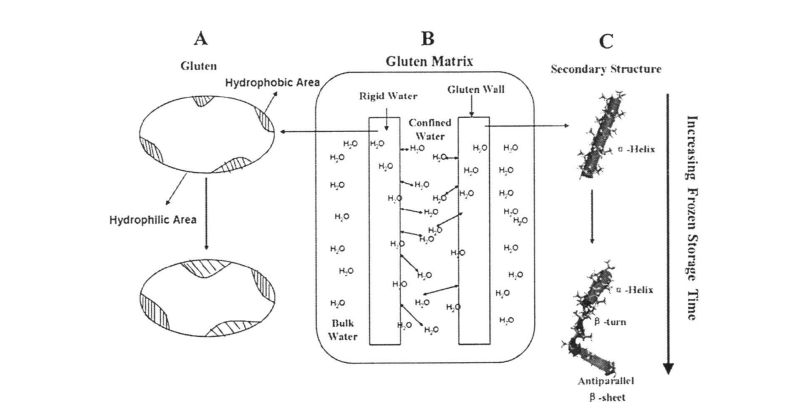
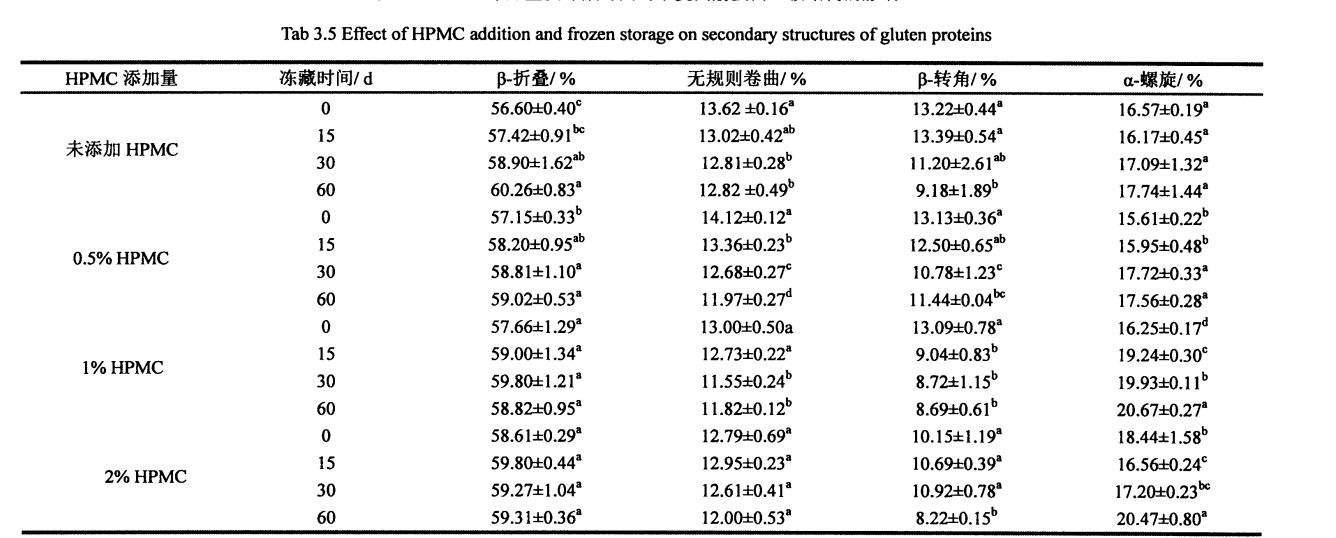
3.3.6 Effeithiau swm adio HPMC ac amser storio rhewi ar hydroffobigedd wyneb protein glwten

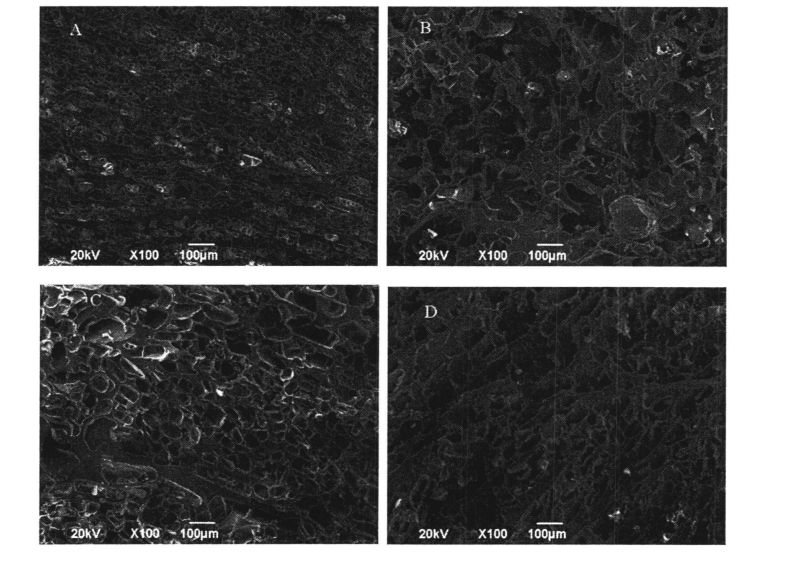
After 60 days of frozen storage, the microstructure of the wet gluten mass without HPMC was significantly changed (Fig. 3.7, AB). Ar 0 diwrnod, roedd y microstrwythurau glwten gyda 2% neu 0% HPMC yn dangos siâp cyflawn, mawr
Morffoleg debyg i sbwng hydraidd bras. However, after 60 days of frozen storage, the cells in the gluten microstructure without HPMC became larger in size, irregular in shape, and unevenly distributed (Fig. 3.7, A, B), mainly due to the This is caused by the fracture of the "wall", which is consistent with the measurement results of the free thiol group content, that is, during the freezing process, the ice crystal squeezes and breaks the disulfide bond, which affects the strength and integrity of the structure. As reported by Kontogiorgos & Goff (2006) and Kontogiorgos (2007), the interstitial regions of the gluten network are squeezed due to freeze-shrinkage, resulting in structural disruption [138. 1391]. In addition, due to dehydration and condensation, a relatively dense fibrous structure was produced in the spongy structure, which may be the reason for the decrease in free thiol content after 15 days of frozen storage, because more disulfide bonds were generated and frozen storage. Ni chafodd y strwythur glwten ei ddifrodi'n ddifrifol am gyfnod byrrach, sy'n gyson â Wang, et A1. (2014) wedi arsylwi ffenomenau tebyg [134]. At the same time, the destruction of the gluten microstructure leads to freer water migration and redistribution, which is consistent with the results of low-field time-domain nuclear magnetic resonance (TD-NMR) measurements. Some studies [140, 105] reported that after several freeze-thaw cycles, the gelatinization of rice starch and the structural strength of the dough became weaker, and the water mobility became higher. Nonetheless, after 60 days of frozen storage, the microstructure of gluten with 2% HPMC addition changed less, with smaller cells and more regular shapes than gluten without HPMC addition (Fig. 3.7, B, D). This further indicates that HPMC can effectively inhibit the destruction of gluten structure by recrystallization.
This experiment investigated the rheology of wet gluten dough and gluten protein by adding HPMC with different contents (0%, 0.5%, 1% and 2%) during freezing storage (0, 15, 30 and 60 days). priodweddau, priodweddau thermodynamig, ac effeithiau priodweddau ffisiocemegol. The study found that the change and redistribution of water state during the freezing storage process significantly increased the freezable water content in the wet gluten system, which led to the destruction of the gluten structure due to the formation and growth of ice crystals, and ultimately caused the processing properties of the dough to be different. Deterioration of product quality. The results of frequency scanning showed that the elastic modulus and viscous modulus of the wet gluten mass without adding HPMC decreased significantly during the freezing storage process, and the scanning electron microscope showed that its microstructure was damaged. The content of free sulfhydryl group was significantly increased, and its hydrophobic group was more exposed, which made the thermal denaturation temperature and surface hydrophobicity of gluten protein significantly increased. However, the experimental results show that the addition of I-IPMC can effectively inhibit the changes in the structure and properties of wet gluten mass and gluten protein during freezing storage, and within a certain range, this inhibitory effect is positively correlated with the addition of HPMC. This is because HPMC can reduce the mobility of water and limit the increase of the freezable water content, thereby inhibiting the recrystallization phenomenon and keeping the gluten network structure and the spatial conformation of the protein relatively stable. This shows that the addition of HPMC can effectively maintain the integrity of the frozen dough structure, thereby ensuring product quality.
Starch is one of the main components of flour, and its content is as high as about 75% (dry basis). Ar yr un pryd, fel carbohydrad sy'n bresennol yn eang mewn grawn, startsh hefyd yw'r prif ddeunydd ffynhonnell ynni mewn bwyd. Yn y system toes, mae startsh yn cael ei ddosbarthu'n bennaf a'i gysylltu â strwythur rhwydwaith protein glwten. Wrth brosesu a storio, mae startsh yn aml yn cael camau gelatinization a heneiddio.
Among them, starch gelatinization refers to the process in which starch granules are gradually disintegrated and hydrated in a system with high water content and under heating conditions. Gellir ei rannu'n fras yn dair prif broses. 1) cam amsugno dŵr cildroadwy; before reaching the initial temperature of gelatinization, the starch granules in the starch suspension (Slurry) keep their unique structure unchanged, and the external shape and internal structure basically do not change. Only very little soluble starch is dispersed in the water and can be restored to its original state. 2) The irreversible water absorption stage; as the temperature increases, water enters the gap between the starch crystallite bundles, irreversibly absorbs a large amount of water, causing the starch to swell, the volume expands several times, and the hydrogen bonds between the starch molecules are broken. It becomes stretched and the crystals disappear. At the same time, the birefringence phenomenon of starch, that is, the Maltese Cross observed under a polarizing microscope, begins to disappear, and the temperature at this time is called the initial gelatinization temperature of starch. 3) Starch granule disintegration stage; starch molecules completely enter the solution system to form starch paste (Paste/Starch Gel), at this time the viscosity of the system is the largest, and the birefringence phenomenon completely disappears, and the temperature at this time is called the complete starch gelatinization temperature, the gelatinized starch is also called α-starch [141]. When the dough is cooked, the gelatinization of starch endows the food with its unique texture, flavor, taste, color, and processing characteristics.
Many studies have shown that the gel strength of starch paste decreases, it is easy to age, and its quality deteriorates under the condition of freezing storage, such as Canet, et a1. (2005) astudiodd effaith tymheredd rhewi ar ansawdd piwrî startsh tatws; Ferrero, et a1. (1993) investigated the effects of freezing rate and different types of additives on the properties of wheat and corn starch pastes [151-156]. However, there are relatively few reports on the effect of frozen storage on the structure and properties of starch granules (native starch), which needs to be further explored. Frozen dough (excluding pre-cooked frozen dough) is in the form of ungelatinized granules under the condition of frozen storage. Therefore, studying the structure and structural changes of native starch by adding HPMC has a certain effect on improving the processing properties of frozen dough. significance.
Wheat Starch Binzhou Zhongyu Food Co., Ltd.; HPMC Aladdin (Shanghai) Chemical Reagent Co., Ltd .;
KDC. Centrifuge oergell cyflym 160awr
Rheomedr cylchdro R3 Discovery
C. 200 Calorimedr Sganio Gwahaniaethol
Wneuthurwr
Grŵp Haier
Huangshi Hengfeng Medical Equipment Co., Ltd.
Huangshi Hengfeng Medical Equipment Co., Ltd.
4.2.3 Dull Arbrofol
Pwyso 1 g o startsh, ychwanegwch 9 ml o ddŵr distyll, ysgwyd a chymysgwch yn llawn i baratoi ataliad startsh 10% (w/w). Yna rhowch yr ateb sampl. 18 ℃ Oergell, storfa wedi'i rewi ar gyfer 0, 15 d, 30 d, 60 d, y mae 0 diwrnod ohono yw'r rheolaeth ffres. Add 0.5%, 1%, 2% (w/w) HPMC instead of the corresponding quality starch to prepare samples with different addition amounts, and the rest of the treatment methods remain unchanged.
Yn yr arbrawf hwn, defnyddiwyd rheomedr yn lle viscometer cyflym i fesur nodweddion gelatinization startsh. Gwel Bae et a1. (2014) method [1571] with slight modifications. The specific program parameters are set as follows: use a plate with a diameter of 40 mill, the gap (gap) is 1000 mm, and the rotation speed is 5 rad/s; I) incubate at 50 °C for 1 min; ii) at 5. C/min heated to 95°C; iii) kept at 95°C for 2.5 min, iv) then cooled to 50°C at 5°C/min; v) lastly held at 50°C for 5 min.
Cymerwch 2.5 g o amyloid a'i gymysgu â dŵr distyll mewn cymhareb o 1: 2 i wneud llaeth startsh. Rhewi ar 18 ° C am 15 d, 30 d, a 60 d. Ychwanegwch 0.5, 1, 2% HPMC (w/w) i ddisodli startsh o'r un ansawdd, ac mae dulliau paratoi eraill yn aros yr un fath. Ar ôl i'r driniaeth rewi gael ei chwblhau, tynnwch hi allan, cydbwyso ar 4 ° C am 4 h, ac yna ei dadmer ar dymheredd yr ystafell nes ei bod yn cael ei phrofi.
Then, sweep the oscillation frequency, set the strain amount (strain) to 0.1% (according to the strain sweep results), and set the frequency range to O. 1 to 10 Hz. Ailadroddwyd pob sampl dair gwaith.
The thawed frozen starch samples were dried in an oven at 40 °C for 48 h, then ground and sieved through a 100-mesh sieve to obtain starch powder samples. Take a certain amount of the above samples, use D/MAX 2500V type X. The crystal form and relative crystallinity were determined by X-ray diffractometer. The experimental parameters are voltage 40 KV, current 40 mA, using Cu. Ks as X. ray source. Ar dymheredd yr ystafell, yr ystod ongl sganio yw 30--400, a'r gyfradd sganio yw 20/min. Relative crystallinity (%) = crystallization peak area/total area x 100%, where the total area is the sum of the background area and the peak integral area [1 62].
Take 0.1 g of the dried, ground and sieved amyloid into a 50 mL centrifuge tube, add 10 mL of distilled water to it, shake it well, let it stand for 0.5 h, and then place it in a 95°C water bath at a constant temperature. After 30 min, after gelatinization is complete, take out the centrifuge tube and place it in an ice bath for 10 min for rapid cooling. Finally, centrifuge at 5000 rpm for 20 min, and pour off the supernatant to obtain a precipitate. Pŵer chwyddo = màs dyodiad/màs sampl [163].
4.2.3.7 Dadansoddi a Phrosesu Data
All experiments were repeated at least three times unless otherwise specified, and the experimental results were expressed as mean and standard deviation. SPSS Statistic 19 was used for analysis of variance (Analysis of Variance, ANOVA) with a significance level of 0.05; Tynnwyd siartiau cydberthynas gan ddefnyddio tarddiad 8.0.
4.3.1 Cynnwys cydrannau sylfaenol startsh gwenith

Mae'r ataliad startsh gyda chrynodiad penodol yn cael ei gynhesu ar gyfradd wresogi benodol i wneud y startsh yn gelatinized. After starting to gelatinize, the turbid liquid gradually becomes pasty due to the expansion of starch, and the viscosity increases continuously. Yn dilyn hynny, mae'r gronynnau startsh yn torri ac mae'r gludedd yn lleihau. Pan fydd y past yn cael ei oeri ar gyfradd oeri benodol, bydd y past yn gel, a bydd y gwerth gludedd yn cynyddu ymhellach. The viscosity value when it is cooled to 50 °C is the final viscosity value (Figure 4.1).

(Frozen storage for 0 days) increased to 1198.09 ± 41.15 CP (frozen storage for 60 days). Correspondingly, the attenuation value of starch suspension without adding HPMC increased from 336.64 ± 71.73 CP (frozen storage for 0 days) to 1027.67 ± 38.72 CP (frozen storage for 60 days); adding 0.5 The attenuation value of starch suspension with %HPMC increased from 303.56±11.22 CP (frozen storage for 0 days) to 833.9±26.45 CP (frozen storage for 60 days); starch suspension with 1% HPMC added The attenuation value of the liquid was increased from 324.19 ± 2.54 CP (freezing for 0 days) to 672.71 ± 10.96 CP (freezing for 60 days); while adding 2% HPMC,the attenuation value of the starch suspension increased from 393.61 ± 45.94 CP (freezing for 0 days) to 557.64 ± 73.77 CP (freezing for 60 days); tra bod yr ataliad startsh heb HPMC wedi ychwanegu bod y gwerth ôl -raddio wedi cynyddu o 403.60 ± 6.13 C.
It can be seen that with the prolongation of freezing storage time, the starch gelatinization characteristics index increased, which is consistent with Tao et a1. f2015) 1. Consistent with the experimental results, they found that with the increase of the number of freeze-thaw cycles, the peak viscosity, minimum viscosity, final viscosity, decay value, and retrogradation value of starch gelatinization all increased to different degrees [166J]. This is mainly because in the process of freezing storage, the amorphous region (Amorphous Region) of starch granules is destroyed by ice crystallization, so that the amylose (the main component) in the amorphous region (non-crystalline region) undergoes phase separation (Phase. separated) phenomenon, and dispersed in the starch suspension, resulting in an increase in the viscosity of starch gelatinization, and an increase in the related attenuation value and retrogradation value. However, the addition of HPMC inhibited the effect of ice crystallization on starch structure. Therefore, the peak viscosity, minimum viscosity, final viscosity, decay value and retrogradation rate of starch gelatinization increased with the addition of HPMC during frozen storage. cynyddu a gostwng yn olynol.

4.3.3 Effeithiau swm adio HPMC ac amser storio wedi'i rewi ar gludedd cneifio past startsh


It can be seen from Table 4.3 that all the flow characteristic indices, 2, are less than 1. Therefore, starch paste (whether HPMC is added or whether it is frozen or not) belongs to Pseudoplastic Fluid, and all show shearing Thinning phenomenon (as the shear rate increases, the shear viscosity of the fluid decreases). In addition, the shear rate scans ranged from 0.1 s, respectively. 1 increased to 100 s ~, and then decreased from 100 sd to O. The rheological curves obtained at 1 sd do not completely overlap, and the fitting results of K, s are also different, so the starch paste is a thixotropic pseudoplastic fluid (whether HPMC is added or whether it is frozen or not). However, under the same freezing storage time, with the increase of HPMC addition, the difference between the fitting results of the K n values of the two scans gradually decreased, which indicates that the addition of HPMC makes the structure of starch paste under shear stress. Mae'n parhau i fod yn gymharol sefydlog o dan y weithred ac yn lleihau'r "cylch thixotropig"
However, with the prolongation of freezing storage time, the values of K and n increased to different degrees, among which the value of K increased from 78.240 ± 1.661 Pa·sn (unadded, 0 days) to 95.570 ± 1, respectively. 2.421 Pa·sn (no addition, 60 days), increased from 65.683±1.035 Pa ·S n (addition of O. 5% HPMC, 0 days) to 51.384±1.350 Pa ·S n (Add to 0.5% HPMC, 60 days), increased from 43.122±1.047 Pa ·sn (adding 1% HPMC, 0 days) to 56.538±1.378 Pa ·sn (adding 1% HPMC, 60 days) ), and increased from 13.926 ± 0.330 Pa ·sn (adding 2% HPMC, 0 days) to 16.064 ± 0.465 Pa ·sn (adding 2% HPMC, 60 days); 0.277 ± 0.011 (without adding HPMC, 0 days) rose to O. 334±0.014 (no addition, 60 days), increased from 0.310±0.009 (0.5% HPMC added, 0 day) to 0.336±0.014 (0.5% HPMC added, 60 days), from 0.323 ± 0.013 (add 1% HPMC, 0 days) to 0.340 ± 0.013 (add 1% HPMC, 60 days), and from 0.431 ± 0.013 (add 1% HPMC, 60 days) 2% HPMC, 0 days) to 0.404+0.020 (add 2% HPMC, 60 days). By comparison, it can be found that with the increase of the addition amount of HPMC, the change rate of K and Knife value decreases successively, which shows that the addition of HPMC can make the starch paste stable under the action of shearing force, which is consistent with the measurement results of starch gelatinization characteristics. yn gyson.

Ffig 4.3 Effaith ychwanegiad HPMC a storfa wedi'i rewi ar fodwlws elastig a gludiog past startsh
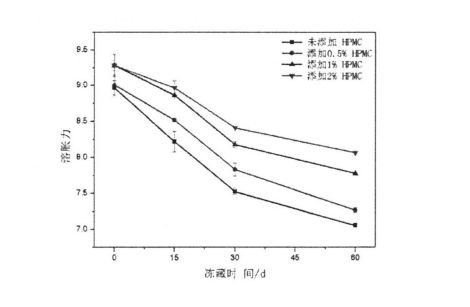
Mae gelatinization startsh yn broses thermodynamig cemegol endothermig. Therefore, DSC is often used to determine the onset temperature (Dead), peak temperature (To), end temperature (T p), and gelatinization enthalpy of starch gelatinization. (Tc). Mae Tabl 4.4 yn dangos cromliniau DSC gelatinization startsh gyda 2% a heb HPMC wedi'i ychwanegu ar gyfer gwahanol amseroedd storio rhewi.
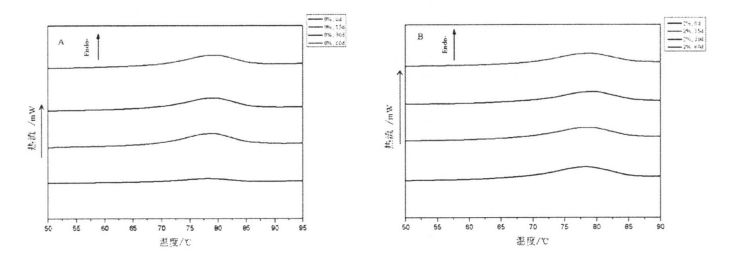
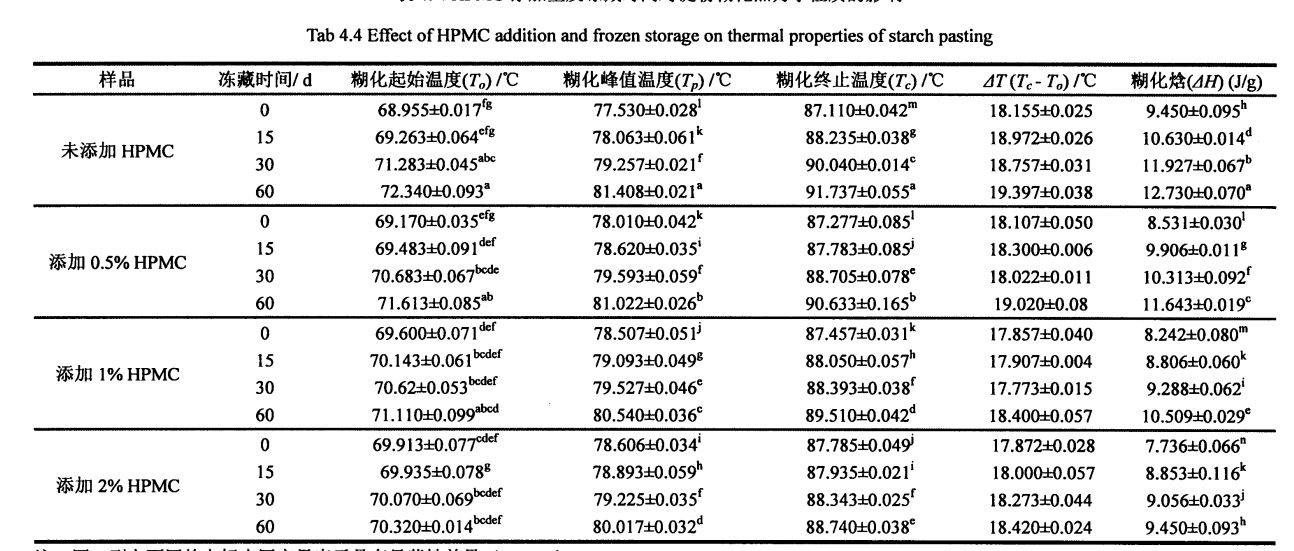
However, with the prolongation of freezing storage time, the relative crystallinity of starch increased from 20.40 + 0.14 (without HPMC, 0 days) to 36.50 ± 0.42 (without HPMC, frozen storage, respectively). 60 diwrnod), a chynyddu o 25.75 + 0.21 (ychwanegwyd 2% HPMC, 0 diwrnod) i 32.70 ± 0.14 (ychwanegwyd 2% HPMC, 60 diwrnod) (Ffigur 4.6.b), hwn a Tao, et a1. (2016), mae rheolau newid y canlyniadau mesur yn gyson [173-174]. The increase in relative crystallinity is mainly caused by the destruction of the amorphous region and the increase in the crystallinity of the crystalline region. In addition, consistent with the conclusion of the changes in the thermodynamic properties of starch gelatinization, the addition of HPMC reduced the degree of relative crystallinity increase, which indicated that during the freezing process, HPMC could effectively inhibit the structural damage of starch by ice crystals and maintain the Its structure and properties are relatively stable.
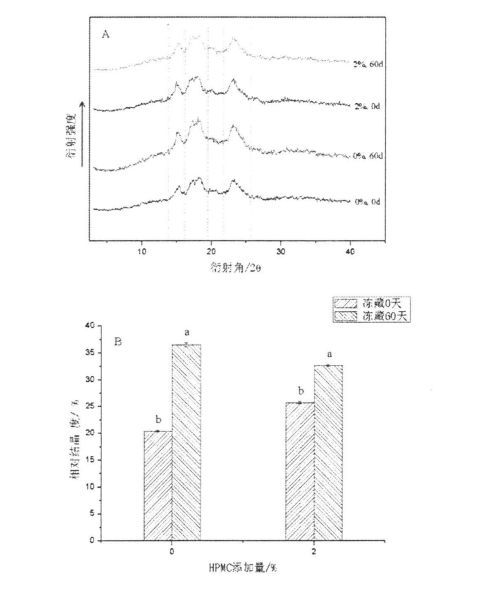
Nodyn: A yw x. X-ray diffraction pattern; B is the relative crystallinity result of starch;
5.2 Deunyddiau a Dulliau
KDC. Centrifuge oergell cyflym 160awr
Wneuthurwr
Jiangsu Tongjing Purification Equipment Co., Ltd.
See Meziani, et a1. Dull arbrofol (2012) [17 dyfynnwyd, gydag addasiadau bach. Weigh 5 g of frozen dough into a 50 mL colorimetric tube, press the dough to a uniform height of 1.5 cm at the bottom of the tube, then place it upright in a constant temperature and humidity box, and incubate for 1 h at 30 °C and 85% RH, after taking it out, measure the proofing height of the dough with a millimeter ruler (retain two digits after the decimal point). For samples with uneven upper ends after proofing, select 3 or 4 points at equal intervals to measure their corresponding heights (for example, each 900), and the measured height values were averaged. Roedd pob sampl yn gyfochrog dair gwaith.
5.2.2.3 CFU (Unedau sy'n Ffurfio Gwladfa) Cyfrif
Weigh 1 g of dough, add it to a test tube with 9 mL of sterile normal saline according to the requirements of the aseptic operation, shake it fully, record the concentration gradient as 101, and then dilute it into a series of concentration gradients until 10'1. Draw 1 mL of dilution from each of the above tubes, add it to the center of the 3M yeast rapid count test piece (with strain selectivity), and place the above test piece in a 25°C incubator according to the operating requirements and culture conditions specified by 3M. 5 d, take out after the end of the culture, first observe the colony morphology to determine whether it conforms to the colony characteristics of yeast, and then count and microscopically examine [179]. Ailadroddwyd pob sampl dair gwaith.
Defnyddiwyd y dull alloxan i bennu'r cynnwys glutathione. Yr egwyddor yw bod gan gynnyrch adweithio glutathione ac alloxan uchafbwynt amsugno ar 305 nl. Specific determination method: pipette 5 mL of yeast solution into a 10 mL centrifuge tube, then centrifuge at 3000 rpm for 10 min, take 1 mL of supernatant into a 10 mL centrifuge tube, add 1 mL of 0.1 mol/mL to the tube L alloxan solution, mixed thoroughly, then add 0.2 M PBS (pH 7.5) and 1 mL of 0.1 M, NaOH solution to it, mix well, let stand for 6 min, and immediately add 1 M, NaOH The solution was 1 mL, and the absorbance at 305 nm was measured with a UV spectrophotometer after thorough mixing. The glutathione content was calculated from the standard curve. Each sample was paralleled three times.
Experimental results are presented as 4-standard deviation of the mean, and each experiment was repeated at least three times. Analysis of variance was performed using SPSS, and the significance level was 0.05. Defnyddiwch darddiad i dynnu graffiau.

5.3.2 Effaith ychwanegiad I-IPMC ac amser rhewi ar gyfradd goroesi burum
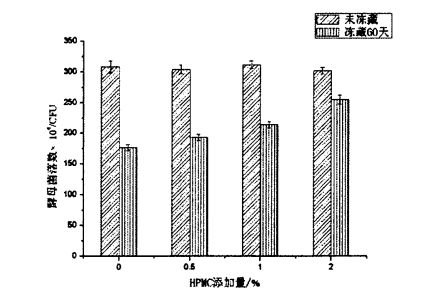
It can be seen from Figure 5.2 that there is no significant difference in the number of yeast colonies in samples with different contents of HPMC added without freezing treatment. Mae hyn yn debyg i'r canlyniad a bennir gan Heitmann, Zannini, & Arendt (2015) [180]. However, after 60 days of freezing, the number of yeast colonies decreased significantly, from 3.08x106 CFU to 1.76x106 CFU (without adding HPMC); from 3.04x106 CFU to 193x106 CFU (adding 0.5% HPMC); reduced from 3.12x106 CFU to 2.14x106 CFU (added 1% HPMC); reduced from 3.02x106 CFU to 2.55x106 CFU (added 2% HPMC). By comparison, it can be found that the freezing storage environment stress led to the decrease of the yeast colony number, but with the increase of HPMC addition, the degree of the decrease of the colony number decreased in turn. This indicates that HPMC can better protect yeast under freezing conditions. The mechanism of protection may be the same as that of glycerol, a commonly used strain antifreeze, mainly by inhibiting the formation and growth of ice crystals and reducing the stress of low temperature environment to yeast. Figure 5.3 is the photomicrograph taken from the 3M yeast rapid counting test piece after preparation and microscopic examination, which is in line with the external morphology of yeast.
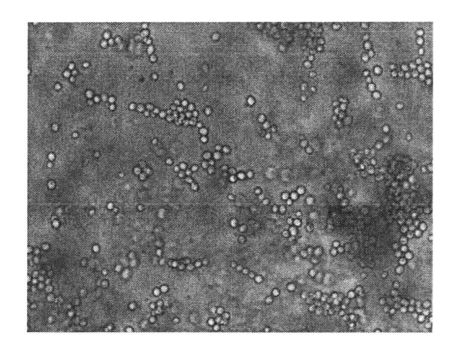
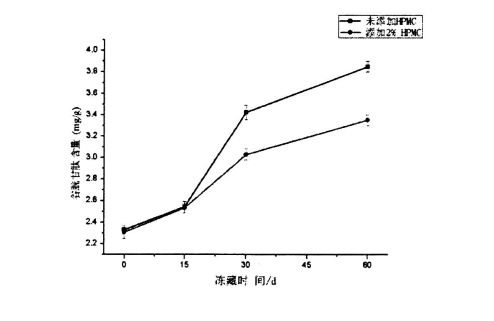
Yeast is an indispensable and important component in fermented flour products, and its fermentation activity will directly affect the quality of the final product. In this experiment, the protective effect of HPMC on yeast in frozen dough system was evaluated by studying the effect of different HPMC additions on yeast fermentation activity, yeast survival number, and extracellular glutathione content in frozen dough. Through experiments, it was found that the addition of HPMC can better maintain the fermentation activity of the yeast, and reduce the degree of decline in the proofing height of the dough after 60 days of freezing, thus providing a guarantee for the specific volume of the final product; in addition, the addition of HPMC effectively The decrease of yeast survival number was inhibited and the increase rate of reduced glutathione content was reduced, thereby alleviating the damage of glutathione to dough network structure. Mae hyn yn awgrymu y gall HPMC amddiffyn burum trwy atal ffurfio a thwf crisialau iâ.
Amser Post: Hydref-08-2022







